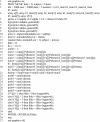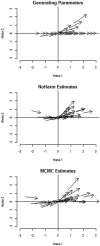Using SAS PROC MCMC for Item Response Theory Models
- PMID: 29795834
- PMCID: PMC5965616
- DOI: 10.1177/0013164414551411
Using SAS PROC MCMC for Item Response Theory Models
Abstract
Interest in using Bayesian methods for estimating item response theory models has grown at a remarkable rate in recent years. This attentiveness to Bayesian estimation has also inspired a growth in available software such as WinBUGS, R packages, BMIRT, MPLUS, and SAS PROC MCMC. This article intends to provide an accessible overview of Bayesian methods in the context of item response theory to serve as a useful guide for practitioners in estimating and interpreting item response theory (IRT) models. Included is a description of the estimation procedure used by SAS PROC MCMC. Syntax is provided for estimation of both dichotomous and polytomous IRT models, as well as a discussion on how to extend the syntax to accommodate more complex IRT models.
Keywords: Markov chain Monte Carlo; item response theory; software.
Conflict of interest statement
Declaration of Conflicting Interests: The author(s) declared no potential conflicts of interest with respect to the research, authorship, and/or publication of this article.
Figures










References
-
- Andrews M., Baguley T. (2013). Prior approval: The growth of Bayesian methods in psychology. British Journal of Mathematical and Statistical Psychology, 66, 1-7. - PubMed
-
- Andrich D. (1978). A rating formulation for ordered response categories. Psychometrika, 43, 561-573.
-
- *Baldwin P., Bernstein J., Wainer H. (2009). Hip psychometrics. Statistics in Medicine, 28, 2277-2292. - PubMed
-
- Bock R. D. (1972). Estimating item parameters and latent ability when responses are scored in two or more nominal categories. Psychometrika, 37, 29-51.
-
- *Bolfarine H., Bazan J. (2010). Bayesian estimation of the logistic positive exponent IRT model. Journal of Educational and Behavioral Statistics, 35, 693-713.
LinkOut - more resources
Full Text Sources
Other Literature Sources
